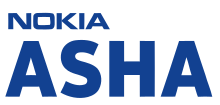
A smartphone is a mobile device that combines the functionality of a traditional mobile phone with advanced computing capabilities. It typically has a touchscreen interface, allowing users to access a wide range of applications and services, such as web browsing, email, and social media, as well as multimedia playback and streaming. Smartphones have built-in cameras, GPS navigation, and support for various communication methods, including voice calls, text messaging, and internet-based messaging apps.
Nokia Series 40, often shortened as S40, is a software platform and application user interface (UI) software on Nokia's broad range of mid-tier feature phones, as well as on some of the Vertu line of luxury phones. It was one of the world's most widely used mobile phone platforms and found in hundreds of millions of devices. Nokia announced on 25 January 2012 that the company has sold over 1.5 billion Series 40 devices. It was not used for smartphones, with Nokia turning first to Symbian, then in 2012–2017 to Windows Phone, and most recently Android. However, in 2012 and 2013, several Series 40 phones from the Asha line, such as the 308, 309 and 311, were advertised as "smartphones" although they do not actually support smartphone features like multitasking or a fully fledged HTML browser.
The Nokia 6000 series or Classic Business series is range of mobile phones marketed by Nokia. This family of phones is notable for their conservative, unisex designs, making them popular with business users.

Nokia 5300 XpressMusic is a slider mobile phone by Nokia, part of the XpressMusic range. It was introduced on 26 September 2006 and released at the end of that year. It runs on Nokia Series 40 3rd Edition FP2.
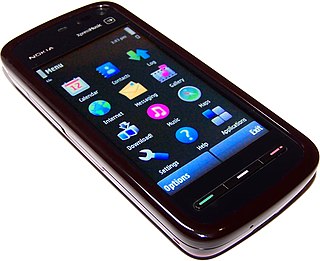
Nokia 5800 XpressMusic is a smartphone part of the XpressMusic line, announced by Nokia on 2 October 2008 in London and started shipping in November of that year. Code-named "Tube", it was the first touchscreen-equipped S60 device by Nokia – essentially it was the first device to run Symbian^1, also known as S60 5th Edition, the touch-specific S60-based platform created by the Symbian Foundation. The touchscreen features tactile feedback.

The Sony Ericsson Satio (U1) is a smartphone, announced by Sony Ericsson at the Mobile World Congress in Barcelona, Spain on 15 February 2009 as the Idou. It was released on 7 October 2009 in the UK in 3 colour schemes: Black, Silver and Bordeaux (Red).

The Nokia N900 is a smartphone made by Nokia. It supersedes the Nokia N810. Its default operating system, Maemo 5, is a Linux-based OS originally developed for the Nokia 770 Internet Tablet. It is the first Nokia device based upon the Texas Instruments OMAP3 microprocessor with the ARM Cortex-A8 core. Unlike the three Nokia Internet tablets preceding it, the Nokia N900 is the first Maemo device to include phone functionality.
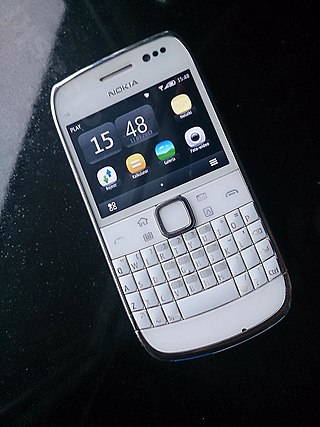
The Nokia E6-00 is a mobile phone running the Symbian^3 operating system. It supersedes the Nokia E72 as the new Symbian business mobility solution from Nokia following its announcement on 12 April 2011. It shipped with the new "Symbian Anna" version of Symbian^3, and originally retailed for 340 euros before taxes.
Nokia's strategic nomenclature can be traced back in 2005 when the Nseries line was launched, offering devices with flagship specifications and premium hardware at various price points. These devices were considered the "bread and butter" of the company and were often positioned to showcase their latest technologies. Thanks to the newfound consumer and enterprise interest in smartphones at the time, the company introduced four additional collections to diversify their product portfolio and meet demands in most market segments. These new phone series were named Eseries, targeting small business and enterprise customers; Xseries, providing consumer-grade multimedia-focused devices; Cseries, which Nokia used to target both the low-end and mid-range market segments; and Tseries, for devices exclusive to the Chinese market.
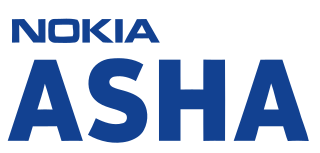
The Nokia Asha 303 is a QWERTY messenger smartphone powered by Nokia's Series 40 operating system. It was announced at Nokia World 2011 in London along with three others Asha phones - the Nokia Asha 200, 201 and 300. The 303 is considered to be the flagship of the Asha family. Its main features are the QWERTY keyboard and capacitive touchscreen, the pentaband 3G radio, SIP VoIP over 3G and Wi-Fi and the ability to play Angry Birds which were all never seen before on a Series 40 phone. Nokia Asha 303 is available in a number of languages depending on which territory it is marketed for. Models sold in South Asia support at least eight languages: English, Hindi, Gujarati, Marathi, Tamil, Kannada, Telugu and Malayalam.

The Nokia Asha 302 is a QWERTY messenger feature phone powered by Nokia's Series 40 operating system. It was announced at Mobile World Congress 2012 in Barcelona along with other Asha phones - the Nokia Asha 202 and 203. The 302 is considered to be among the flagship of the Asha family. Its main features are the QWERTY keyboard, the pentaband 3G radio, SIP VoIP over 3G and Wi-Fi. Its design looks a lot like the older Nokia E6 with chrome slidings, giving it a somewhat premium look. A software update adds Mail for Exchange support.

The Nokia Asha 311 is a "Full Touch" smartphone powered by Nokia's Series 40 operating system. It was announced at Bangkok by Nokia along with two others Asha Full Touch phones - the Nokia Asha 305 and 306. The 311 is considered to be the flagship of the Asha Full Touch family. Its main features are the Full Touch capacitive touchscreen, the pentaband 3G radio, SIP VoIP over 3G and Wi-Fi and the ability to play games. Nokia Asha 311 is available in a number of languages depending on which territory it is marketed for.

The Nokia Asha 200 & Nokia Asha 201 are budget-level additions to the Nokia Asha family released in Q4 2011. Both devices run the Nokia S40 mobile operating system. There is no direct predecessor of the phones, though the closest to it is the Nokia X2-01, which has similar features and a very similar user interface, as well as having better music capabilities. The Nokia C3 is also an indirect predecessor, also using similar features, though the C3 is a higher end device. The phones are successors to the Nokia X1-01, as they use the same bright colors and the same Dual SIM support for Nokia Asha 200.

The Nokia Asha series is a discontinued a range of low-end feature phones and smartphones produced and marketed by Nokia. The name "Asha" came from the Hindi word meaning "hope".

The Nokia Asha 305 is a "Full Touch" phone powered by Nokia's Series 40 operating system. It was announced at Bangkok by Nokia along with two other Asha Full Touch phones - the Nokia Asha 306 and 311. Its main features are the Full Touch resistive touchscreen and dual SIM.
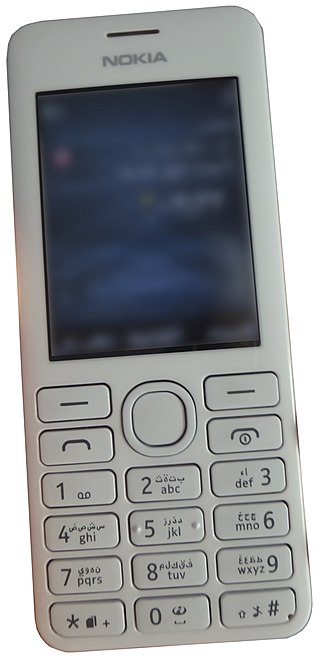
Nokia 206 is an entry level dual-SIM mobile phone from Nokia. It was announced alongside the Nokia Asha 205 in November 2012 and was first released in January 2013. It is the successor to the Nokia Asha 200 and Nokia Asha 201. However, the 206 is not an Asha device.

Nokia Asha 501 is a low-end smartphone from the Nokia Asha series, announced by Nokia on 9 May 2013 in India, and released on 24 June 2013. The device is classified by Nokia as a "Full Touch" smartphone. The phone is available in either single- or dual SIM configuration.

The Samsung Galaxy Star is a low-end smartphone manufactured by Samsung Electronics. It is running on Android 4.1.2(Jelly Bean). It has unofficial Android 4.4, 5.1, 6.0.1 and 7.1 roms. It was announced in April 2013, it was subsequently released in May 2013. It is the cheapest smartphone in the Samsung Galaxy series. Like all other Samsung Galaxy smartphones, the Galaxy Star runs on the Android mobile operating system. The phone is available in 2 versions: a single SIM version (GT-S5280) and a dual SIM version (GT-S5282). The phone competes with other low-cost smartphones such as the smartphones from the Nokia Asha series as well as low-cost smartphones manufactured by Indian manufacturers such as Micromax, Karbonn, Spice Digital, Lava International and Celkon. It is available in certain Asian countries such as India, Pakistan, Sri Lanka, Nepal, Bangladesh, Myanmar, Philippines, Indonesia etc. where low-cost smartphones are very popular as well as in Morocco, Algeria, South Africa, Portugal, France, Germany, Russia and Ukraine. Brazilian version is also released, dubbed GT-S5283B.

The Nokia Asha 310, also known as the Nokia Asha 3010 or the Nokia ASHA 310 RM-911, was released in March 2013. It is the first in the line of the Asha range of phones to have dual subscriber identity module (SIM) slots and Wi-Fi connectivity. It was a reinvention of the Asha range to remain competitive with new Android devices. It cost $102.00 at its launch date. It has a touchscreen, comes with either a 2 or 4 GB micro SD card, and has 64 MB of RAM, a 2 MP camera and a battery that can last up to 600 hours in standby mode. The phone can play music for up to 54 hours or video for up to 9.5 hours, and has a maximum of 17 hours talk time (2G).
The Nokia 3-digit series are a series of feature and smartphones by HMD Global and previously by Microsoft Mobile and Nokia, generally aimed at developing markets.
